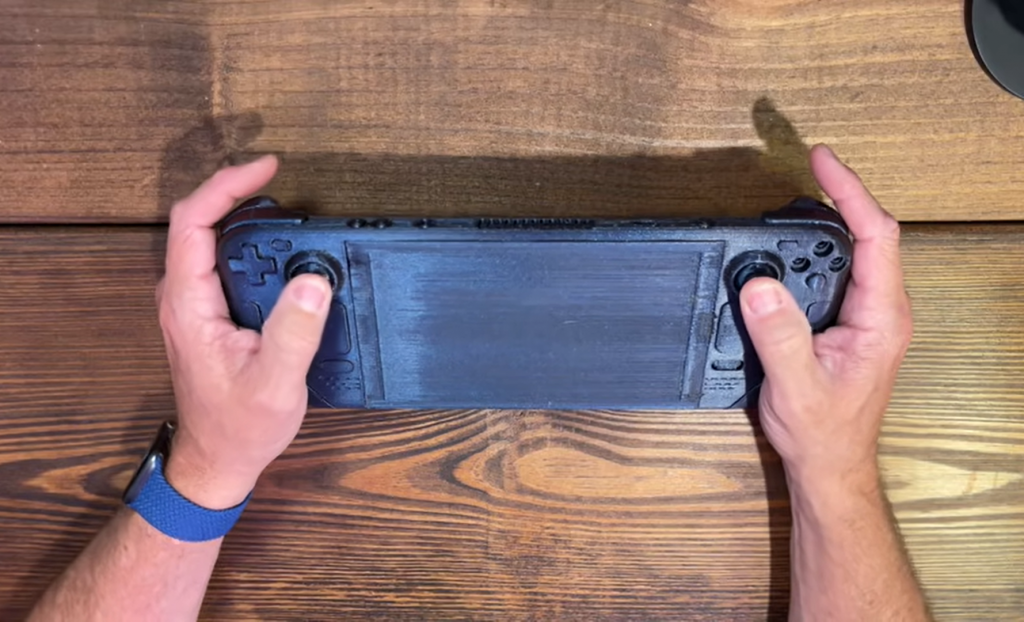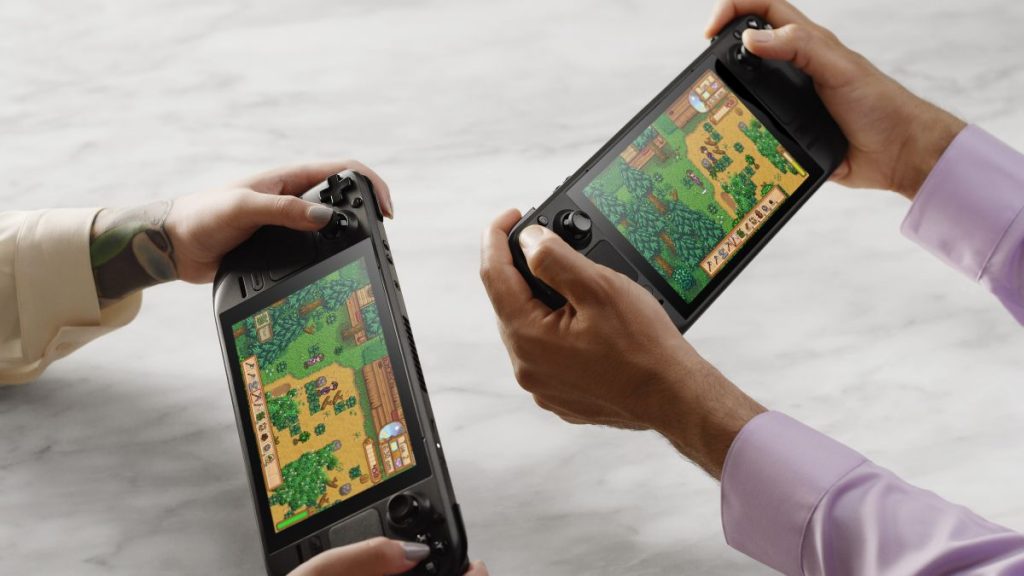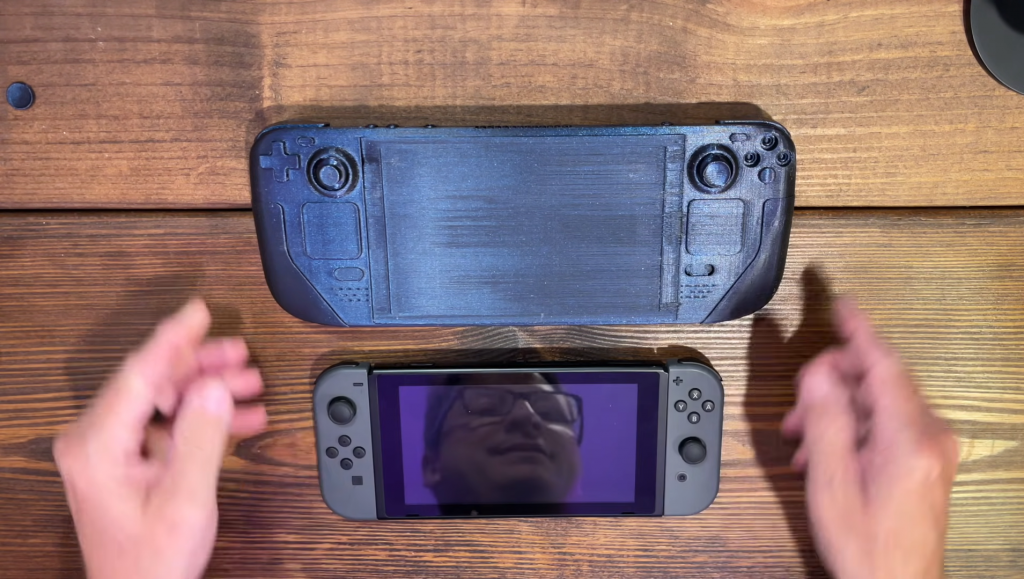Gaming YouTuber Handheld Obsession has 3D printed a full-scale replica of Valve’s upcoming Steam Deck system, revealing a number of preliminary concerns regarding the device’s ergonomics.
Set to be launched in December 2021, the Steam Deck has been a major talking point in the gaming community since its reveal earlier this month. Intended as a fully-functional handheld gaming PC, the system has reportedly run every single Windows game Valve has thrown at it (albeit at 30fps).
Naturally, many of these games were designed to be played on a mouse and keyboard or conventional controller, so the Steam Deck’s portable form factor immediately struck prospective fans as odd. Fortunately for the modern-day consumer, low-cost 3D printing is as accessible as ever, giving us a hands-on preview of how the device might feel in person.
Handheld Obsession said, “I really wanted to know how the Steam Deck felt in my hands. I could have the 3D printed parts on a little bit better, but it gives you an idea and you know how it’s going to feel in your hands.”

Going handheld with the Steam Deck
Up until now, Nintendo has unequivocally been the one to sit on the handheld throne, promising travellers, commuters, and anyone else with restless legs the ability to game on the go. With the announcement of the Steam Deck, Valve is very boldly muscling in on the handheld gaming market, but the lack of a demonstrated history is understandably a cause for concern when it comes to physical design, ergonomics, and comfort.
As far as specifications go, however, the Steam Deck certainly doesn’t disappoint. Underneath the 7” LCD touchscreen is a custom Linux operating system, an AMD APU (Zen 2 CPU and RDNA 2 GPU), and eight Compute Units for a total of 512 cores. The device will also feature 16GB of RAM, up to 512GB of SSD storage, and a resolution of 1280 x 800 – all in a 669g package.

A 3D printed preview
Handheld Obsession’s 3D printed Steam Deck is an exact 1:1 scale model (STL available here). In his video, he runs over everything from the thumbstick and button placements to the quality and feel of the device’s grips.
Straight off the bat, he states that the thumbstick locations are virtually perfect, and should feel natural regardless of the user’s hand size. Where the Steam Deck’s layout falters is the B button, which is the one furthest to the right. From the video alone, it’s clear that the B button might be too close to the edge, meaning the thumb might interfere with the index finger when the user goes to press the right shoulder button along the top of the device. The dual touchpads were also a source of worry, as they turned out to require an awkwardly angled thumb adjustment.
Since most modern twin-stick games use the analog sticks for movement and aiming and the triggers for firing, the B button placement shouldn’t be a major issue. Where it might be an issue is with 2D fighting games, as they often require the buttons and triggers to be pressed simultaneously. Still, the Steam Deck isn’t marketed for high-level competitive use, so this should be one of the factors considered before a purchase.
He concludes, “Overall I’m quite happy with the feel of this device, I really am. It’s quite a bit better than I anticipated. It’s big, chunky and actually comfortable, other than my one concern with the B button and the pad, which seems a little bit too low. But I’m really looking forward to it.”

3D printing technology enables content creators like Handheld Obsession to showcase their passion projects and better demonstrate their points in a very visual manner. Earlier this month, DIY technology YouTuber befinitiv used a low-cost 3D printer to turn a 50-year-old analog camera into a digital one. By swapping out the film canister of a vintage Cosina Hi-Lite DLR with a Raspberry Pi and its 3D printed housing, he was able to capture full HD images and record videos, as well as live-stream his videos to his computer over Wi-Fi.
Elsewhere, 3D printing YouTuber Teaching Tech designed and 3D printed his own open-source version of a rare antique fractal vise. Dubbed ‘the coolest tool you didn’t know you needed’, the 100-year-old fractal vise is near impossible to purchase these days, and is capable of morphing to grip virtually any object, regardless of the complexity of the geometry.
Nominations for the 2021 3D Printing Industry Awards are now open, have your say in who is leading the industry now.
Subscribe to the 3D Printing Industry newsletter for the latest news in additive manufacturing. You can also stay connected by following us on Twitter, liking us on Facebook, and tuning into the 3D Printing Industry YouTube Channel.
Looking for a career in additive manufacturing? Visit 3D Printing Jobs for a selection of roles in the industry.
Featured image shows Handheld Obsession’s 3D printed Steam Deck. Photo via Handheld Obsession.


